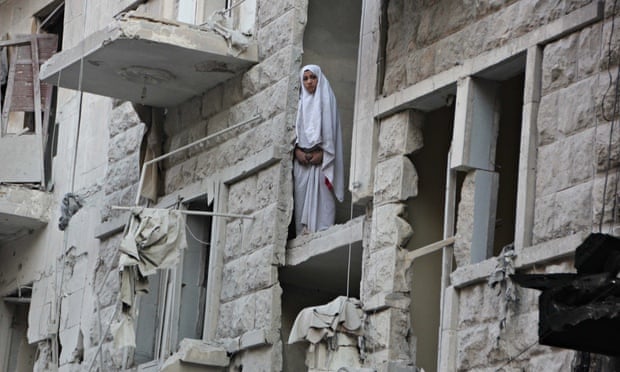Assad regime says scheme to curb fighting in Aleppo and improve access to aid is worth studying, but rebels are divided
Ian Black, Middle East editor
The Guardian

Plans for ending the war in Syria have come and gone, but there is a new flurry of interest in the idea that “freezing” the front lines and expanding local ceasefires may be the only way to stop – or at least to limit – the misery, mayhem and killing.
Staffan de Mistura, the third UN envoy to tackle the crisis since 2011, went public this week with an action plan for Aleppo, which is divided between government and rebel forces and where the population is desperate for any respite. President Bashar al-Assad’s office said the idea was worth studying. But reactions from rebels ranged from the sceptical to the hostile. Past truces, many warned, have been little more than surrenders that have benefited Assad and restored only a semblance of normality to hungry and war-weary Syrians.
De Mistura described Aleppo, Syria’s historic commercial capital, as an obvious candidate for “incremental freeze zones” to stop fighting and allow better access to humanitarian aid.
The broader concept has been explored in several recent proposals, which all call for a “bottom-up strategy” to wind down the war in the absence of any coherent international peace-making strategy and the immense impact of the jihadis ofIslamic State (Isis).
“Local solutions may be the best model for de-escalating the conflict,” suggested the Geneva-based Centre for Humanitarian Dialogue in a document seen by the Guardian. “There are simply too many insurgent groups with too many interests and agendas, local and international, to be able to reach a global agreement.”
The hope, it says, is that local truces will “spread like inkblots” across the country, where an estimated 200,000 people have died in the last three and a half years and half the population has been displaced. A related idea, put forward by the Carnegie Endowment expert Yezid Sayigh, is for “comprehensive … unilateral truces, undertaken separately but in parallel”.
In another new report, the Syrian civil society NGO Madani teamed up with researchers from the London School of Economics to argue that local initiatives can save lives, though they must be integrated with “top-down” diplomatic efforts. “After three and a half painful years, Syrians are yearning for peace,” said Rim Turkmani, the lead author of the report. It looked at 35 ceasefires, studying factors including the release of detainees and the provision of services. In Barzeh, near Damascus, the terms of the truce were reneged on. Media reports described how government forces were able to redeploy and regain access to a nearby pro-Assad neighbourhood housing military families who had been cut off by the fighting.
Conditions were often affected by the influence of outsiders and vested interests in a war economy that has created huge opportunities for profit. The Syrian government has used what has been called a “siege and starvation” strategy that allowed it to impose its will on rebel-held areas. In the old city of Homs, the report said, “it was only once residents were confronted with a complete lack of medical services and the prospect of starving to death that pressure from civilians was enough to start negotiations”.
Independent experts have warned that the local ceasefire strategy will play into the hands of the government. Emile Hokayem of the International Institute for Strategic Studies called it “the worst well intentioned idea”. However, it commands significant support among Syrians, especially refugees, and with the current intense western focus on Isis and little hope of a return to the Geneva talks, there are few other solutions around.
Diplomats say important questions need to be answered about the monitoring mechanism for truces, the role to be played by the UN and the prospects for imposing sanctions if the parties fail to comply. The position of the US, currently noncommittal, is extremely important.
“The Assad regime wants ceasefires everywhere now,” said an opposition activist with close links to armed groups. “It is similar to the situation in 2007 and 2008, when Syria was isolated and it started making noises about a peace deal with Israel.
“Surprise, surprise, there was no deal. But it got a process, which is what it wanted. And that’s what it wants now. Let’s get everyone talking about ceasefires, not about giving up power or offering substantive reforms. It’s all about wrong-footing countries like Turkey and Saudi Arabia and playing on America’s wish not to get involved – and on the fear of Isis.”

No comments:
Post a Comment